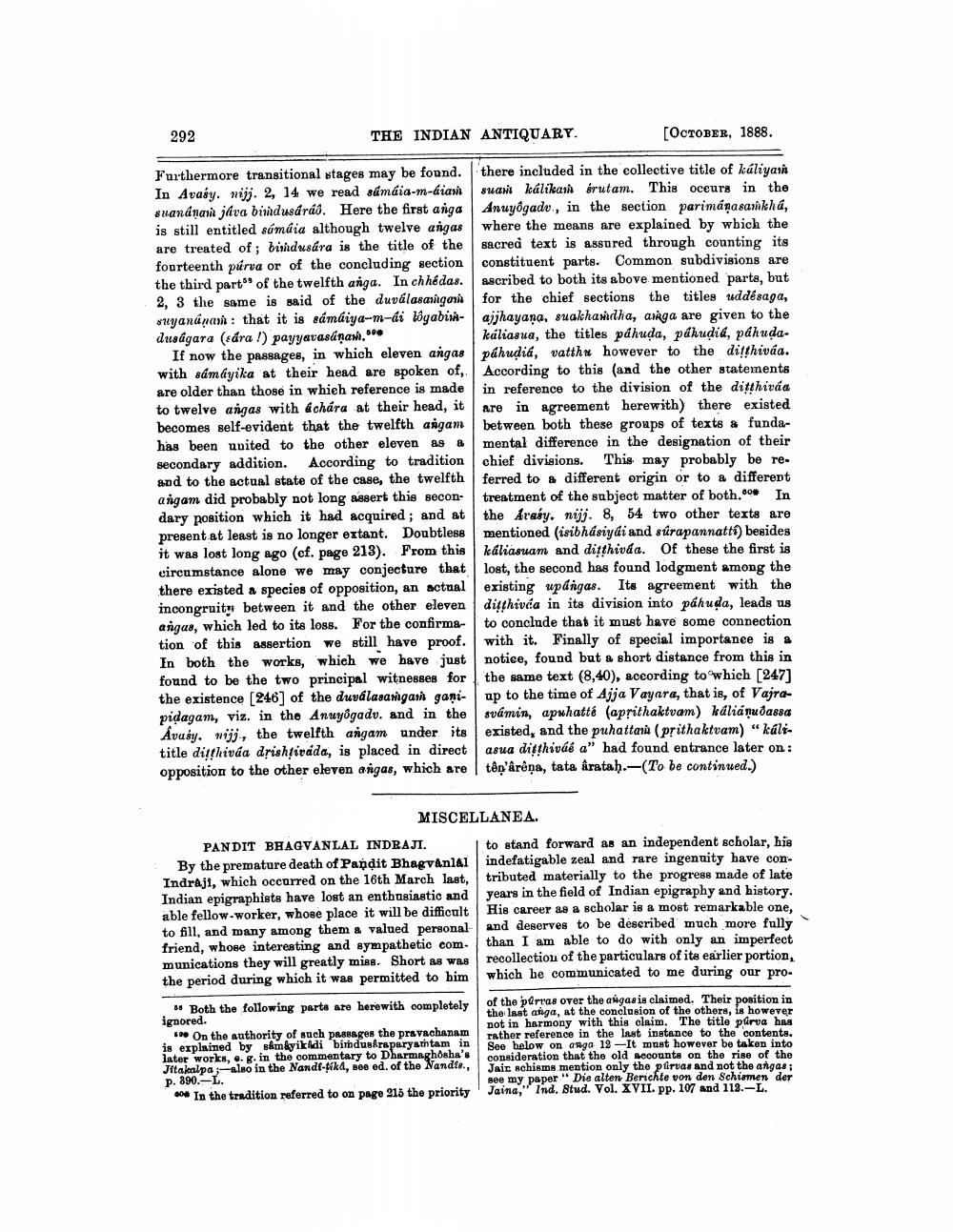________________
292
THE INDIAN ANTIQUARY.
[OCTOBER, 1888.
Furthermore transitional stages may be found. there included in the collective title of káliyari In Avasy. wijj. 2, 14 we read sámáia-m-diam suami kálikani śrutam. This occurs in the suandnari java bundusaráð. Here the first aliga Anuyógadv., in the section parimanasarikha, is still entitled sómáia although twelve angas where the means are explained by wbich the are treated of; bidusára is the title of the sacred text is assured through counting its fourteenth purva or of the concluding section constituent parts. Common subdivisions are the third part of the twelfth anga. In chhedas. ascribed to both its above mentioned parts, but 2, 3 the same is said of the duválasaigani for the chief sections the titles uddésaga, suyana mani: that it is sámáiya-m-ái ôgabi- ajjhayana, suakhandha, araga are given to the duságara (sára !) payyarasunani.***
káliasua, the titles páhuda, pahudia, pahudaIf now the passages, in which eleven angas pähudia, vatthu however to the ditthivaa. with sámáyika at their head are spoken of, According to this and the other statements are older than those in which reference is made in reference to the division of the ditthivaa to twelve angas with áchára at their head, it are in agreement herewith) there existed becomes self-evident that the twelfth angam between both these groups of texts a fundahas been united to the other eleven as a mental difference in the designation of their secondary addition. According to tradition chief divisions. This may probably be reand to the actual state of the case, the twelfth ferred to a different origin or to a different angam did probably not long assert this secon- treatment of the subject matter of both. In dary position which it had acquired ; and at the Arasy. nijj. 8, 54 two other texts are present at least is no longer extant. Doubtless mentioned (isibhásiydi and súrapannatti) besides it was lost long ago (ef. page 213). Prom this káliasuam and ditthivda. Of these the first is circumstance alone we may conjecture that lost, the second has found lodgment among the there existed a species of opposition, an actual existing upangas. Its agreement with the incongruity between it and the other elevendithivca in its division into páhuda, leads us angas, which led to its loss. For the confirma- to conclude that it must have some connection tion of this assertion we still have proof. with it. Finally of special importance is a In both the works, which we have just notice, found but a short distance from this in found to be the two principal witnesses for the same text (8,40), aceording to which [247] the existence [246] of the duválasangan gani- up to the time of Ajja Vayara, that is, of Vajrapidagam, viz. in the Anuyôgadv. and in the svámin, apuhatte (aprithaktvam) káliánudassa Avasy. nijj, the twelfth angam under its existed, and the puhattara (prithaktvam) “kálttitle ditthiváa drishtirada, is placed in direct asua ditthiváé a" had found entrance later on: opposition to the other eleven angas, which are têņ'ârêņa, tata aratah.-(To be continued.)
MISCELLANEA. PANDIT BHAGVANLAL INDRAJI. to stand forward as an independent scholar, his By the premature death of Pandit Bhagvanlal indefatigable zeal and rare ingenuity have conIndraji, which occurred on the 16th March last, tributed materially to the progress made of late Indian epigraphists have lost an enthusiastic and years in the field of Indian epigraphy and history. able fellow-worker, whose place it will be difficult His career as a scholar is a most remarkable one, to fill, and many among them a valued personal
and deserves to be described much more fully friend, whose interesting and sympathetic com. than I am able to do with only an imperfect munications they will greatly miss. Short as was recollectiou of the particulars of its earlier portion, the period during which it was permitted to him which he communicated to me during our pro.
# Both the following parts are herewith completely
of the perras over the angasis claimed. Their position in ignored.
the last ariga, at the conclusion of the others, is however
not in harmony with this claim. The title prirva has *** On the authority of such passages the pravachanam rather reference in the last instance to the contents. is explained by sk&yikidi birhduskraperyarhtam in
See below on anga 12-It must however be taken into later works, or in the commentary to Dharmaghsha's
consideration that the old recounts on the rise of the Jitallpa-also in the Nandf-tika, see ed. of the Nandie.,
Jaic schisma mention only the pervas and not the angas; p. 890.-L.
see my paper" Die alten Berichte von den Schismen der * In the tradition referred to on page 215 the priority 'Jaina," Ind. Stud. Vol. XVII. pp. 107 and 113.-L.




